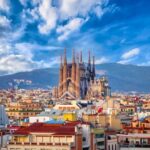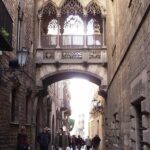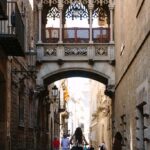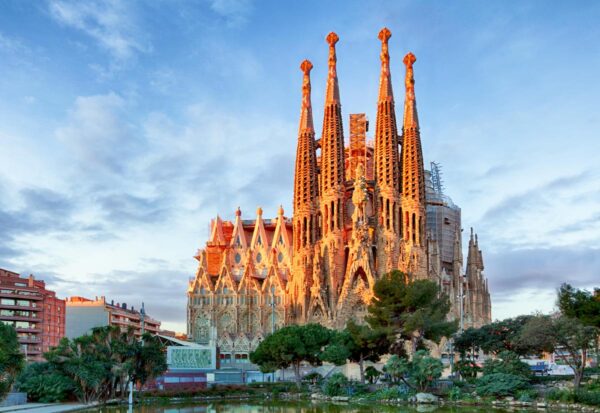
La Sagrada Familia, a stunning basilica designed by Antoni Gaudí, stands as a testament to the unique blend of architectural vision and spiritual devotion. This iconic structure has captivated visitors for over a century with its intricate details and towering spires, making it one of Barcelona's most recognizable landmarks.
In this article, we will explore The Fascinating Facts about La Sagrada Familia - Barcelona's Iconic Masterpiece, revealing the secrets behind its construction, the inspiration that shaped its design, and the ongoing efforts to complete this remarkable work of art. Join us as we delve into the stories that make La Sagrada Familia a true marvel of human creativity.
The Architectural Genius of Antoni Gaudí: La Sagrada Familia
Antoni Gaudí's approach to architecture transcended the traditional norms of his time, infusing La Sagrada Familia with a unique organic style that mimics the forms found in nature. This innovative design philosophy is evident in the basilica's intricate facades and towering columns, which resemble trees reaching toward the sky. Gaudí's understanding of geometry allowed him to create structures that are not only aesthetically pleasing but also remarkably functional.
One of the most striking aspects of Gaudí's genius is his use of light within the basilica. The play of light through stained glass windows illuminates the interior with a kaleidoscope of colors, enhancing the spiritual atmosphere of the space. This careful consideration of light showcases how Gaudí harmonized structural elements with natural phenomena, creating a sense of serenity and connection to the divine.
Furthermore, Gaudí incorporated a variety of architectural styles, including Gothic and Art Nouveau, while embedding symbols and motifs that reflect his deep faith. Each element of La Sagrada Familia tells a story, from the Nativity facade depicting the birth of Christ to the Passion facade representing his crucifixion. This intricate symbolism makes the basilica not just a work of art but also a profound narrative of spirituality.
To illustrate Gaudí's architectural innovations, here is a brief comparison of some unique features of La Sagrada Familia:
| Feature | Description |
|---|---|
| Spiral Towers | Inspired by natural forms, each tower represents a different biblical figure. |
| Hyperboloid Structures | These shapes allow for greater strength and stability, exemplifying Gaudí's mastery of engineering. |
| Nature Motifs | Floral and faunal designs are integrated throughout the basilica, bridging architecture and the natural world. |
Exploring the Symbolism Behind La Sagrada Familia's Design
The design of La Sagrada Familia is steeped in symbolism, reflecting Antoni Gaudí's deep religious convictions and his desire to create a space that inspires awe and reverence. Each architectural element is imbued with meaning, serving as a visual narrative of the Christian faith. For instance, the three grand façades represent significant events in the life of Jesus: the Nativity, the Passion, and the Glory, each meticulously crafted to convey distinct spiritual messages.
Gaudí's use of natural forms plays a crucial role in the basilica's design. The columns inside the basilica resemble tree trunks, branching out to support the vaulted ceiling, which evokes a forest canopy. This organic approach is not only visually stunning but also symbolizes the connection between the divine and the natural world, emphasizing the belief that nature is a manifestation of God's creation.
Another fascinating aspect of the basilica's design is the integration of light and color. The carefully placed stained glass windows serve a dual purpose: enhancing the aesthetic experience while also conveying religious themes. As sunlight filters through the vibrant glass, it creates a spectrum of colors that transforms the interior, inviting visitors to reflect on the spiritual significance of light as a symbol of divine presence.
To further understand the layers of meaning in La Sagrada Familia's design, consider the following key symbols embedded within its structure:
- Spiral Towers: Each tower is dedicated to a different biblical figure, representing their unique contributions to the faith.
- The Paschal Candle: The central altar features a large candle, symbolizing the light of Christ and the promise of resurrection.
- Nature-Inspired Designs: The abundance of floral motifs and animal carvings bridge the gap between spirituality and the natural environment.
Construction Timeline: The Ongoing Journey of La Sagrada Familia
The construction of La Sagrada Familia began in 1882, driven by architect Francisco de Paula del Villar. However, it was Antoni Gaudí, who took over the project in 1883, that transformed the basilica into a masterpiece of modernist architecture. Gaudí's vision included innovative engineering techniques and a deep spiritual narrative, marking the beginning of an extraordinary journey that continues to this day.
Over the years, La Sagrada Familia has faced various challenges, including the Spanish Civil War, which halted construction and resulted in the destruction of many of Gaudí's plans. Despite these setbacks, the project has seen remarkable progress, with each new generation of architects and builders contributing to Gaudí's original vision. The anticipated completion date is set for 2026, coinciding with the centenary of Gaudí's death.
The ongoing journey of La Sagrada Familia can be summarized through several key milestones:
- 1882: The foundation stone is laid, marking the start of construction.
- 1883: Gaudí takes over the project, introducing his unique architectural style.
- 1936: The Spanish Civil War interrupts construction, leading to significant losses.
- 2026: Expected completion, aligning with the 100th anniversary of Gaudí's death.
Today, La Sagrada Familia stands not only as a work of art but also as a symbol of perseverance and dedication. The collaborative efforts of architects, artisans, and craftsmen reflect the enduring spirit of Gaudí's vision, making it a remarkable journey through time that continues to inspire awe in visitors from around the world.
A Closer Look at the Unique Facades of La Sagrada Familia
The facades of La Sagrada Familia are a stunning showcase of Antoni Gaudí's artistic vision, each telling a different story through intricate details and symbolism. The three main facades – the Nativity, the Passion, and the Glory – reflect various stages of Christ's life and the essence of Christian faith. The Nativity facade, with its exuberant decorations, captures the joy of Christ's birth, while the stark lines of the Passion facade depict the somber reality of his crucifixion.
One of the most remarkable features of these facades is their use of natural forms. Gaudí drew inspiration from nature, incorporating organic shapes and motifs that reflect the beauty of the world around us. For example, the Nativity facade is adorned with sculptures of animals, plants, and intricate carvings that evoke the harmony of creation. This connection to nature enhances the spiritual experience, reminding visitors of the divine presence in the world.
The Glory facade, still under construction, aims to represent Christ's resurrection and ultimate glory. This facade will feature a grand entrance to the basilica, symbolizing the transition from earthly life to the spiritual realm. As visitors approach, they will encounter a symphony of architectural elements that merge light, form, and detail, inviting them to contemplate the deeper meanings of faith and existence.
Additionally, Gaudí utilized light as a fundamental element in the facade designs. Each facade is strategically positioned to capture sunlight at different times of the day, creating a dynamic interplay of shadows and highlights. This thoughtful arrangement not only enhances the aesthetic appeal but also serves to illuminate the spiritual significance embedded within the architecture, allowing the facades to come alive as the sun moves across the sky.
The Importance of La Sagrada Familia in Barcelona's Cultural Heritage
La Sagrada Familia is not only a stunning architectural achievement but also a vital part of Barcelona's cultural heritage. As a UNESCO World Heritage Site, it represents the pinnacle of Catalan Modernism and showcases the innovative spirit of Antoni Gaudí. The basilica's unique design and intricate details reflect the city's identity and history, attracting millions of visitors each year who come to experience its spiritual and artistic significance.
Moreover, La Sagrada Familia serves as a cultural symbol of unity and resilience for the people of Barcelona. Throughout its lengthy construction, which has spanned over a century, the basilica has become a focal point for community events and celebrations. Its ongoing development is a testament to the collective dedication of architects, artisans, and the local population, further solidifying its role as a beacon of cultural pride.
In addition to its architectural brilliance, La Sagrada Familia plays a crucial role in promoting tourism, significantly contributing to the city's economy. As one of the most visited monuments in Spain, it helps to foster international interest in Barcelona's rich artistic heritage. This influx of tourists not only supports local businesses but also encourages cultural exchange, making the basilica a vital link between Barcelona and the world.
Lastly, La Sagrada Familia embodies the fusion of spirituality and art, inviting visitors to reflect on deeper themes of faith and existence. Its design elements are imbued with religious symbolism, creating a space that resonates with a diverse range of people. This profound connection to spirituality enhances its importance in Barcelona's cultural landscape, positioning it as a masterpiece that continues to inspire and uplift generations.
Visitor Tips: Making the Most of Your Experience at La Sagrada Familia
When visiting La Sagrada Familia, planning ahead can significantly enhance your experience. Consider purchasing your tickets online to avoid long queues, especially during peak tourist seasons. By securing your entry in advance, you can spend more time admiring the basilica's stunning details instead of waiting in line. Additionally, consider visiting early in the morning or later in the afternoon when crowds are typically smaller.
To fully appreciate the architectural marvel, taking a guided tour is highly recommended. A knowledgeable guide can provide you with insights into Gaudí's vision and the intricate symbolism embedded in the basilica's design. Many tours also include access to areas of the basilica that are not open to the general public, offering a unique perspective on this iconic structure. Here are some options you might consider:
- Audio guides available in multiple languages for self-paced exploration.
- Group tours that delve deep into the history and architecture.
- Private tours for a more personalized experience.
Another tip for making the most of your visit is to take your time exploring the surrounding area. The park next to La Sagrada Familia, Plaça de Gaudí, provides a lovely space to relax and take in the views of the basilica from different angles. Don’t forget to capture some photographs as the light changes throughout the day, highlighting the stunning details of Gaudí's masterpiece. Lastly, consider bringing a sketchbook or a journal to document your thoughts and impressions, as the spiritual atmosphere of La Sagrada Familia is sure to inspire reflection.
 Smooth Transfers: From Sagrada Familia to Barcelona Airport - A Guide for Travelers
Smooth Transfers: From Sagrada Familia to Barcelona Airport - A Guide for Travelers Barcelona's Gothic Quarter: Roman Roots
Barcelona's Gothic Quarter: Roman Roots Navigating Barcelona's Gothic Quarter
Navigating Barcelona's Gothic QuarterIf you want to know other articles similar to The Fascinating Facts about La Sagrada Familia - Barcelona's Iconic Masterpiece you can visit the category WHERE YOU CAN GO.
Leave a Reply










Read more!